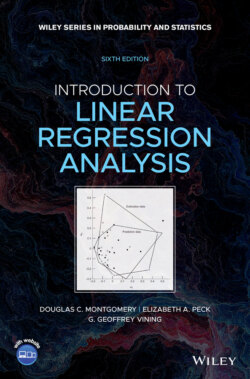Читать книгу Introduction to Linear Regression Analysis - Douglas C. Montgomery - Страница 42
Example 2.6 The Rocket Propellant Data
ОглавлениеConsider finding a 95% CI on E(y|x0) for the rocket propellant data in Example 2.1. The CI is found from Eq. (2.43) as
If we substitute values of x0 and the fitted value at the value of x0 into this last equation, we will obtain the 95% CI on the mean response at x = x0. For example, if , then , and the CI becomes
Table 2.6 contains the 95% confidence limits on E(y|x0) for several other values of x0. These confidence limits are illustrated graphically in Figure 2.4. Note that the width of the CI increases as increases.
TABLE 2.6 Confidence Limits on E(y|x0) for Several Values of x0
| Lower Confidence Limit | x 0 | Upper Confidence Limit |
| 2438.919 | 3 | 2593.821 |
| 2341.360 | 6 | 2468.481 |
| 2241.104 | 9 | 2345.836 |
| 2136.098 | 12 | 2227.942 |
| 2086.230 | 2176.571 | |
| 2024.318 | 15 | 2116.822 |
| 1905.890 | 18 | 2012.351 |
| 1782.928 | 21 | 1912.412 |
| 1657.395 | 24 | 1815.045 |
Figure 2.4 The upper and lower 95% confidence limits for the propellant data.
Many regression textbooks state that one should never use a regression model to extrapolate beyond the range of the original data. By extrapolation, we mean using the prediction equation beyond the boundary of the x space. Figure 1.5 illustrates clearly the dangers inherent in extrapolation; model or equation error can severely damage the prediction.
Equation (2.43) points out that the issue of extrapolation is much more subtle; the further the x value is from the center of the data, the more variable our estimate of E(y|x0). Please note, however, that nothing “magical” occurs at the boundary of the x space. It is not reasonable to think that the prediction is wonderful at the observed data value most remote from the center of the data and completely awful just beyond it. Clearly, Eq. (2.43) points out that we should be concerned about prediction quality as we approach the boundary and that as we move beyond this boundary, the prediction may deteriorate rapidly. Furthermore, the farther we move away from the original region of x space, the more likely it is that equation or model error will play a role in the process.
This is not the same thing as saying “never extrapolate.” Engineers and economists routinely use prediction equations to forecast a variable of interest one or more time periods in the future. Strictly speaking, this forecast is an extrapolation. Equation (2.43) supports such use of the prediction equation. However, Eq. (2.43) does not support using the regression model to forecast many periods in the future. Generally, the greater the extrapolation, the higher is the chance of equation error or model error impacting the results.
The probability statement associated with the CI (2.43) holds only when a single CI on the mean response is to be constructed. A procedure for constructing several CIs that, considered jointly, have a specified confidence level is a simultaneous statistical inference problem. These problems are discussed in Chapter 3.
